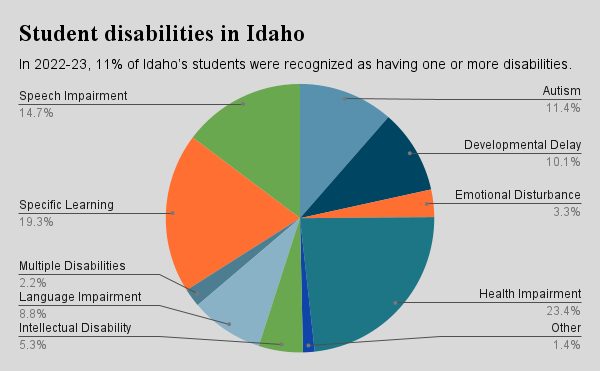
The State Board of Education made a one-word change in the state’s special education manual Wednesday.
The change could help hundreds, or possibly thousands, of Idaho students with disabilities, who have been deprived of the support they should have received under federal law.
But the move could also place more pressure on a special education system already showing serious signs of strain — including a budget gap of $80 million, and growing.
The State Board-approved fix has been in the pipeline for almost a year.
In October, federal officials alerted the Idaho Department of Education to a problem in the special education manual. It centers on eligibility criteria for students with a “specific learning disability,” such as dyslexia, brain injury or developmental aphasia.
For years, the state has applied a two-step test for eligibility. Before moving a student with an SLD into a special education program, school officials needed to document a significant learning gap and a failure to respond to intervention.
“We literally had to change one word, from an ‘and’ to an ‘or,’” said chief deputy superintendent Ryan Cantrell, a former special education teacher in the rural Bruneau-Grand View School District.
State Board members supported the change unanimously. But first, board President Linda Clark tried to get a sense of how it might affect special education numbers.
“Logic would tell me, President Clark, that the number would go up,” Cantrell said.
“Logic would tell me it may go up significantly,” Clark replied. “It’s a much less rigorous standard.”

The Brittain Group, a law firm that advocates for children with dyslexia, has said the state has misdiagnosed thousands of students over the years. A state review, spanning from October 2023 to March, found about 377 students were affected.
Either way, the cost of compliance — and extending help to eligible students — comes as the special education budget gap continues to widen.
State superintendent Debbie Critchfield offered the State Board a sobering update Wednesday: She said local school districts are subsidizing federal special education funding to the tune of about $80 million. When Critchfield first brought the issue to light last fall, she pegged the gap at $66.5 million.
That isn’t the only troubling trend.
Over the past two years, the state has received an increased number of complaints about special education programs, Critchfield said. (Idaho EdNews’ Carly Flandro has written extensively about complaints surrounding the Oneida School District’s online programs, the Garden Valley district and the Elevate Academy charter schools.)
The silver lining: Critchfield said she convened a listening session recently to discuss special education. She expected the discussion to dissolve into finger-pointing, but it didn’t. And one new item came out of the conversations: a “pocket guide” designed to help parents make sense of the complexities of special education.
Helping parents navigate and advocate is one thing. But it doesn’t solve the money crunch — and the practical challenges of helping some 37,000 students with special needs.
The $80 million gap is a real and growing problem for schools already facing a variety of budget headwinds. Federal COVID aid is drying up — and districts used the vast majority of this one-time money to cover ongoing personnel costs. Student numbers are dropping in many districts, affecting state funding. In some communities, voters are saying no to supplemental levies that help districts plug budget holes.
On top of all of this, schools face an added pressure when it comes to special education. The feds’ “maintenance of effort” law requires stable, or increased, special education spending. If a cash-challenged district has to cut spending, it can’t look to special education to find savings.
The 2025 Legislature could step in — reducing this $80 million gap, and helping schools cover the cost of supporting students with SLDs.
On Wednesday, Critchfield didn’t bring up her ongoing push to rewrite the school funding formula. But Critchfield hasn’t abandoned the idea. She wants to add student “weights” to the 30-year-old funding formula, providing schools additional money based on at-risk student populations. Among other things, this change would give schools additional special education funding.
Critchfield also foreshadowed one new wrinkle in her 2025-26 budget proposal, which goes to Gov. Brad Little next week. She wants to create a line item geared toward “high-cost” students — and cases where an individual student’s need might force a district to cut another program.
It will be up to the 2025 Legislature to decide on the SLD guidelines. The State Board’s rule change is in effect now, and until the session.
But it will also be up to Little, and ultimately legislators, to decide whether to earmark state money for special education students. The needs of 37,000 students aren’t going away — and an $80 million budget problem isn’t getting any better.
Kevin Richert writes a weekly analysis on education policy and education politics. Look for his stories each Thursday.
